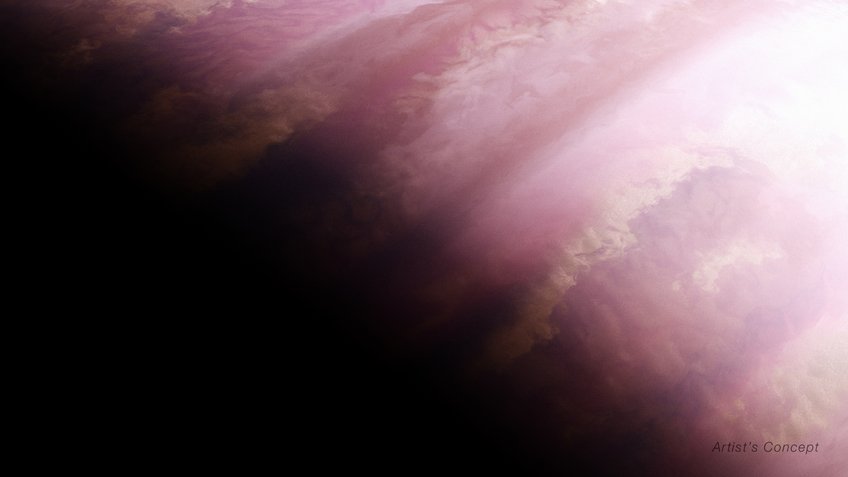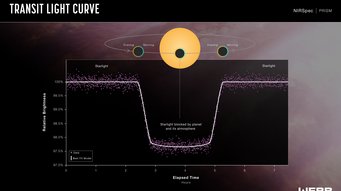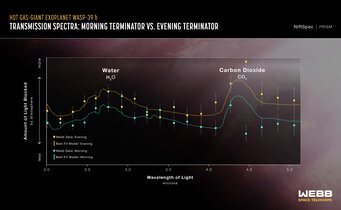Webb finds differences in the eternal morning and evening skies on a distant world
First clear evidence of conditions varying between the morning and evening transition zones separating the day and night sides of a tidally locked hot Jupiter
Researchers, including astronomers from the Max Planck Institute for Astronomy (MPIA), have finally confirmed what models have previously predicted: that an exoplanet has variations between its morning and evening atmosphere, exhibiting different temperatures and cloud coverages. The results follow from infrared observations of the giant gas planet WASP-39 b using the James Webb Space Telescope (JWST). The planet is tidally locked to its parent star, leading to a constant dayside and nightside. One hemisphere of the planet is always exposed to its star, while the other is shrouded in darkness.
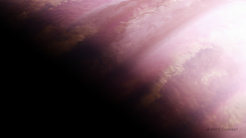
Using JWST’s NIRSpec (Near-Infrared Spectrograph), astronomers confirmed a temperature difference between the morning and evening, with the evening appearing hotter by roughly 200 degrees Celsius. They also found clues that the morning could be cloudier than the evening.
“This is the first time that a separate measurement of a direct evening and morning spectrum of an exoplanet has been possible,” said Maria Steinrück, an astronomer at the University of Chicago, USA, who contributed to the research when she was working at the Max Planck Institute for Astronomy (MPIA), Heidelberg, Germany. She is also a co-author of the underlying article in Nature. “This method can greatly help with understanding the climate of exoplanets.”
The variation of the signals the telescope received from both regions is minute. Resolving this slight difference is only possible due to JWST’s and NIRSpec’s sensitivity across near-infrared wavelengths and the instrument’s extremely stable sensors. “Any tiny movement in the instrument or with the observatory while collecting data would have severely limited our ability to make this detection. It must be extraordinarily precise, and Webb is just that,” said Néstor Espinoza, an exoplanet researcher at the Space Telescope Science Institute (STScI) and Johns Hopkins University in Baltimore, USA, and lead author of the study.
Earlier results couldn’t distinguish morning from evening
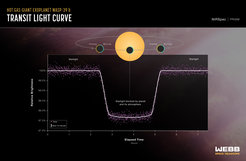
Previously published data of WASP-39b’s atmosphere obtained with the JWST revealed the presence of carbon dioxide, sulfur dioxide, water vapour, and sodium across the entire day-to-night boundary. There was no detailed attempt to differentiate between one side and the other. The ability to detect such rich chemistry was already ground-breaking in its own right.
At that time, astronomers analyzed the two- to five-micrometre transmission spectrum of WASP-39 b. This technique studies the exoplanet’s terminator, the boundary that separates the planet’s dayside and nightside. The observations produce a transmission spectrum by comparing starlight filtered through a planet’s atmosphere as it moves in front of the star to the unfiltered starlight detected when the planet is beside the star. When making that comparison, researchers obtain information about the temperature, composition, and other properties of the planet’s atmosphere. WASP-39 b’s inflated, puffy atmosphere helps the starlight interact efficiently with atoms and molecules, producing a strong filtered signal.
New analysis finds slight differences between morning and evening skies
The analysis of the new data takes the next step and yields two different spectra from the terminator region, essentially splitting the day-to-night boundary into two semicircles, one from the evening and the other from the morning. Data reveals the evening as significantly hotter, a searing 800 degrees Celsius, and the morning a relatively cooler 600 degrees Celsius.
“There have been similar attempts to observe morning and evening terminators with ground-based telescopes, but interference from the Earth’s atmosphere invalidates most of the spectral information,” explained Steinrück.
Extensive data modelling also allows researchers to investigate the structure of WASP-39 b’s atmosphere and its cloud cover, and provides hints as to why the evening is hotter. While future work by the team will investigate how the cloud cover may affect temperature and vice versa, astronomers confirmed gas circulation around the planet as the main culprit of the temperature difference on WASP-39 b.
Strong winds may explain the variations
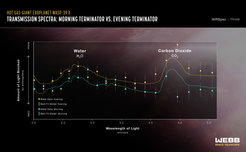
On a highly irradiated exoplanet like WASP-39 b that orbits relatively close to its star, researchers generally expect the gas to be moving as the planet rotates around its star: hotter gas from the dayside should move through the evening to the nightside via a powerful equatorial jet stream. Since the temperature difference is so extreme, the air pressure difference would also be significant, which in turn would cause high wind speeds.
Using General Circulation Models, three-dimensional models similar to the ones used to predict weather patterns on Earth, researchers indeed found that on WASP-39 b, the prevailing winds are moving from the nightside across the morning terminator, around the dayside, across the evening terminator and then around the nightside again. “The new results are crucial to refine our computational models of exoplanet atmospheres,” explained Steinrück, who led the team running the climate models and produced the model spectra used to interpret the observations.
“This result is a big step forward in measuring the full three-dimensional structure of an exoplanet,” said Laura Kreidberg, Director of MPIA’s Atmospheric Physics of Exoplanets (APEx) Department, Steinrück’s previous workplace. “Computer simulations from Maria Steinrück were critical to building a physical picture from the complex data. Her work showed that the difference between the planet’s morning and evening can be explained by violent winds on the planet that circulate hot air from dayside to nightside and blow clouds from nightside to dayside. With speeds reaching 10,000 kilometres per hour or more, these winds are four times faster than those on Neptune, the windiest planet in our Solar System,” added Kreidberg, who is also a co-author.
“This new analysis is also particularly interesting because you’re getting 3D information on the planet that you weren’t getting before,” added Espinoza. “Because we can tell that the evening edge is hotter, that means it’s a little puffier. So, theoretically, there is a small swell at the terminator approaching the nightside of the planet.”
The researchers will now look to use the same analysis method to study atmospheric differences of other tidally locked hot Jupiters as part of JWST’s Cycle 2 General Observers Program 3969.
Background information
The MPIA scientists involved in this study are Maria Steinrück (now University of Chicago, USA; 51 Pegasi b Fellow), Laura Kreidberg, Duncan Christie, Eva-Maria Ahrer (also University of Warwick, Coventry, UK), and David Hägele (also Heidelberg University, Germany).
Other researchers include Néstor Espinoza (Space Telescope Science Institute and Johns Hopkins University, Baltimore, USA), Ryan MacDonald (University of Michigan, Ann Arbor, USA), James Kirk (Imperial College London, London and University of Warwick, Coventry, UK), as well as Arjun Savel, Kenneth Arnold, and Eliza Kempton (all University of Maryland, College Park, USA).
NIRSpec is part of the European Space Agency’s (ESA) contribution to the Webb mission, built by a consortium of European companies led by Airbus Defence and Space (ADS). NASA’s Goddard Space Flight Centre provided two sub-systems (detectors and micro-shutters). MPIA was responsible for procuring electrical components of the NIRSpec grating wheels.
JWST is the world’s premier space science observatory. It is an international program led by NASA jointly with its partners, ESA (European Space Agency) and CSA (Canadian Space Agency).
WASP-39 b was among the first targets JWST observed as it began regular science operations in 2022. The data in this study was collected under the Early Release Science program 1366, designed to help scientists quickly learn how to use the telescope’s instruments and realize its full scientific potential.
This press release is an adaptation of the one published by STScI/NASA (Writer: Hannah Braun).
MN
